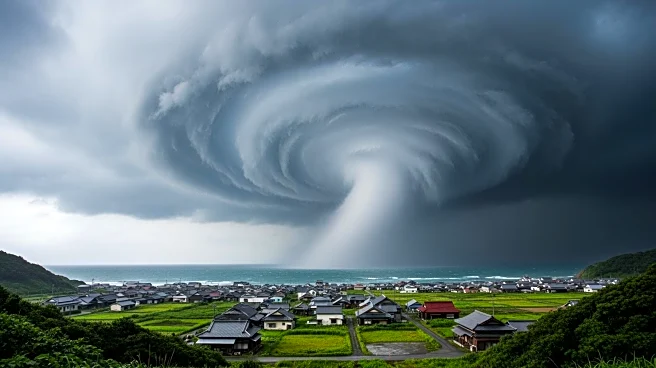What's Happening?
A powerful earthquake struck off the coast of Iwate Prefecture in northern Japan on Sunday evening, prompting the Japan Meteorological Agency to issue a tsunami advisory. The earthquake, initially reported
with a magnitude of 6.9 and a depth of 16 kilometers, occurred at 5:03 p.m. local time. Although there were no immediate reports of injuries or damage, the agency warned of potential tsunami waves reaching up to 3 meters in height. Tsunami waves of about 10 centimeters were detected at several locations, including Ofunato city and Ominato port. The advisory was lifted three hours later, but the agency cautioned that the region could experience strong quakes for up to a week, particularly in the next few days. The area is historically prone to earthquakes, including the devastating 2011 disaster that resulted in a nuclear meltdown in Fukushima.
Why It's Important?
The earthquake and subsequent tsunami advisory highlight the ongoing vulnerability of northeastern Japan to seismic activity. This region has a history of significant earthquakes, including the 2011 disaster that led to widespread devastation and long-term displacement of residents. The advisory serves as a reminder of the potential risks associated with living in an earthquake-prone area, particularly near nuclear power plants. The event underscores the importance of preparedness and the need for effective early warning systems to mitigate the impact of natural disasters. Additionally, it raises concerns about the safety and resilience of infrastructure in regions susceptible to frequent seismic activity.
What's Next?
Following the lifting of the tsunami advisory, the Japan Meteorological Agency has warned that the region may experience further strong quakes over the next week. Residents are advised to remain vigilant and prepared for potential aftershocks. Authorities may conduct assessments of infrastructure and nuclear power plants to ensure safety and readiness for future seismic events. The government and local agencies are likely to review and update emergency response plans to enhance preparedness and minimize risks. Public demonstrations may continue to address concerns about nuclear power safety and the long-term impact of past disasters.
Beyond the Headlines
The earthquake serves as a reminder of the ethical and environmental considerations surrounding nuclear power in earthquake-prone regions. The 2011 Fukushima disaster continues to influence public opinion and policy regarding nuclear energy. The event may prompt renewed discussions on the balance between energy needs and safety concerns, as well as the role of renewable energy sources in reducing reliance on nuclear power. Additionally, the earthquake highlights the cultural resilience of communities in northeastern Japan, who have faced repeated challenges from natural disasters.












